how spacex become success
SpaceX journey from failures to success. Know how space giant achieve so many milestone in short period of time. What are the Spacex major projects and their goals

Tuesday, October 10, 2023 | Chimniii Desk
Space Exploration Technologies Corp. (doing business as SpaceX) is an American spacecraft manufacturer, space launch provider, and a satellite communications corporation headquartered in Hawthorne, California. It was founded in 2002 by Elon Musk, with the goal of reducing space transportation costs to enable the colonization of Mars. It manufactures the Falcon 9 and Falcon Heavy launch vehicles, several rocket engines, Cargo Dragon, crew spacecraft, and Starlink communications satellites.
Advertisement
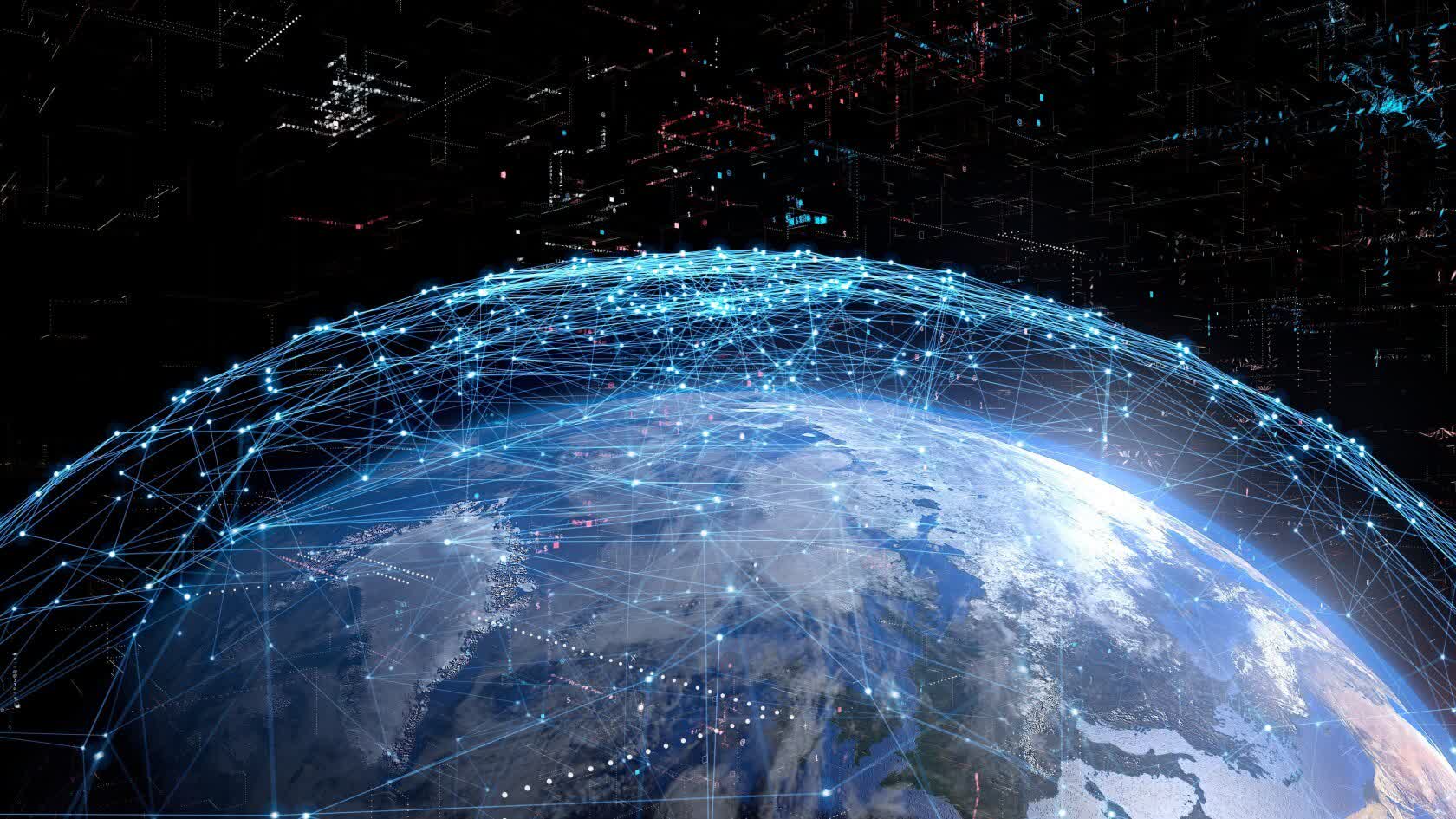
Advertisement
SpaceX is developing a satellite internet constellation named Starlink to provide commercial internet service. In January 2020, the Starlink constellation became the largest satellite constellation ever launched, and as of September 2022 comprises over 3,000 small satellites in orbit. The company is also developing Starship, a privately funded, fully reusable, super heavy-lift launch system for interplanetary and orbital spaceflight. It is intended to become SpaceX's primary orbital vehicle once operational, supplanting the existing Falcon 9, Falcon Heavy, and Dragon fleet. It will have the highest payload capacity of any orbital rocket ever built on its debut, scheduled for 2022 pending launch license.
SpaceX's achievements include the first privately funded liquid-propellant rocket to reach orbit around Earth; the first private company to successfully launch, orbit, and recover a spacecraft; the first private company to send a spacecraft to the International Space Station; the first vertical take-off and vertical propulsive landing for an orbital rocket booster; first reuse of such booster; and the first private company to send astronauts to orbit and to the International Space Station. SpaceX has flown and landed the Falcon 9 series of rockets over one hundred times.
2001–2004: Founding
In early 2001, Elon Musk donated $100,000 to the Mars Society and joined its board of directors for a short time. He was offered a plenary talk at their convention where he announced Mars Oasis, a project to land a miniature experimental greenhouse and grow plants on Mars, to revive public interest in space exploration.Musk initially attempted to acquire a Dnepr ICBM for the project through Russian contacts from Jim Cantrell.However two months later, the United States withdrew from the ABM Treaty and created the Missile Defense Agency, increasing tensions with Russia and generating new strategic interest for rapid and re-usable launch capability similar to the DC-X.
Advertisement

Advertisement
When Musk returned to Moscow, Russia with Michael Griffin (who led the CIA's venture capital arm In-Q-Tel), they found the Russians increasingly unreceptive. On the flight home Musk announced that he could start a company to build the affordable rockets they needed instead. By applying vertical integration, using cheap commercial off-the-shelf components when possible, and adopting the modular approach of modern software engineering, Musk believed SpaceX could significantly cut launch price. Griffin would later be appointed NASA administrator and award SpaceX a $396 million contract before SpaceX had ever flown a rocket.
In early 2002, Musk started to look for staff for his new space company, soon to be named SpaceX. Musk approached rocket engineer Tom Mueller (later SpaceX's CTO of propulsion) and invited him to become his business partner. Mueller agreed to work for Musk, and thus SpaceX was born. SpaceX was first headquartered in a warehouse in El Segundo, California. Early SpaceX employees such as Tom Mueller (CTO), Gwynne Shotwell (COO) and Chris Thompson (VP of Operations) came from neighboring TRW and Boeing corporations following the cancellation of the Brilliant Pebbles program. By November 2005, the company had 160 employees.Musk personally interviewed and approved all of SpaceX's early employees. Musk has stated that one of his goals with SpaceX is to decrease the cost and improve the reliability of access to space, ultimately by a factor of ten.
2005–2009: Falcon 1 and first orbital launches
SpaceX developed its first orbital launch vehicle, the Falcon 1, with internal funding. The Falcon 1 was an expendable two-stage-to-orbit small-lift launch vehicle. The total development cost of Falcon 1 was approximately US$90 million to US $100 million. The Falcon name was adopted from the DARPA Falcon Project, part of the Prompt Global Strike program of the US military.
In 2005, SpaceX announced plans to pursue a human-rated commercial space program through the end of the decade, a program that would later become the Dragon spacecraft. In 2006, the company was selected by NASA to provide crew and cargo resupply demonstration contracts to the ISS under the COTS program.
The first two Falcon 1 launches were purchased by the United States Department of Defense under a program that evaluates new US launch vehicles suitable for use by DARPA. The first three launches of the rocket, between 2006 and 2008, all resulted in failures, which almost ended the company. Financing for Tesla Motors had failed, as well, and consequently Tesla, SolarCity, and Musk personally were all nearly bankrupt at the same time. Musk was reportedly "waking from nightmares, screaming and in physical pain" because of the stress.
Advertisement

Advertisement
The financial situation started to turn around when the first successful launch was achieved soon afterward with the fourth attempt on 28 September 2008. Musk split his remaining $30 million between SpaceX and Tesla, and NASA awarded the first Commercial Resupply Services (CRS) contract to SpaceX in December, thus financially saving the company. Musk received outside funding from local entrepreneur T.Boone Pickens Jr.Based on these factors and the further business operations they enabled, the Falcon 1 was soon retired following its second successful, and fifth total, launch in July 2009; this allowed SpaceX to focus company resources on the development of a larger orbital rocket, the Falcon 9. Gwynne Shotwell was also promoted to company president at this time, for her role in successfully negotiating the CRS contract with the NASA Administrator (and former SpaceX contractor) Michael Griffin.
2010–2012: Falcon 9, Dragon, and NASA contracts
SpaceX originally intended to follow its light Falcon 1 launch vehicle with an intermediate capacity vehicle, the Falcon 5. The company instead decided in 2005 to proceed with the development of the Falcon 9, a reusable heavier lift vehicle. Development of the Falcon 9 was accelerated by NASA, which committed to purchase several commercial flights if specific capabilities were demonstrated. This started with seed money from the Commercial Orbital Transportation Services (COTS) program in 2006.The overall contract award was US$278 million to provide development funding for the Dragon spacecraft, Falcon 9, and demonstration launches of Falcon 9 with Dragon. As part of this contract, the Falcon 9 launched for the first time in June 2010 with the Dragon Spacecraft Qualification Unit, using a mockup of the Dragon spacecraft.
Advertisement
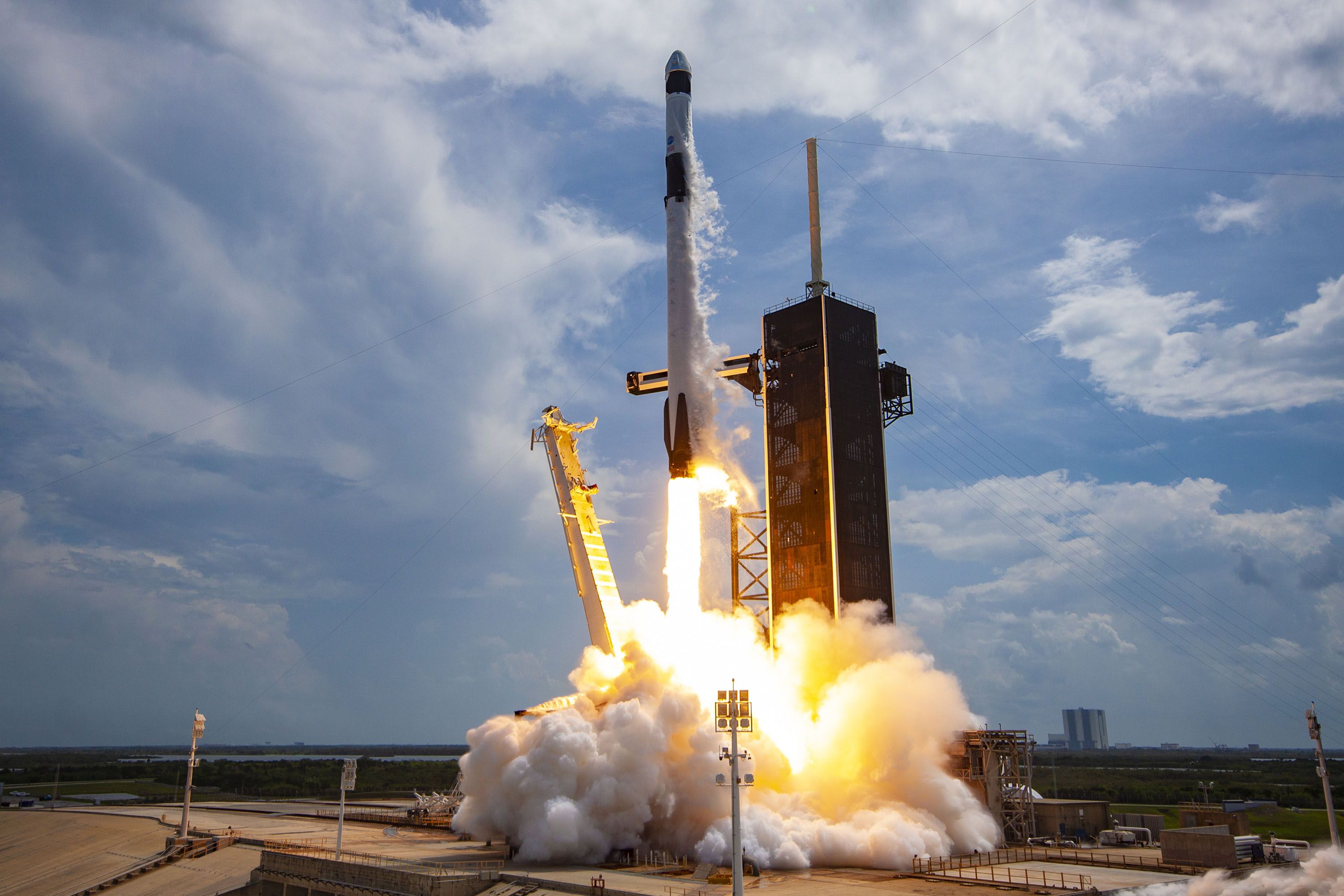
Advertisement
The first operational Dragon spacecraft was launched in December 2010 aboard COTS Demo Flight 1, the Falcon 9's second flight, and safely returned to Earth after two orbits, completing all its mission objectives. By December 2010, the SpaceX production line was manufacturing one Falcon 9 and Dragon every three months.
In April 2011, as part of its second-round Commercial Crew Development (CCDev) program, NASA issued a US$75 million contract for SpaceX to develop an integrated launch escape system for Dragon in preparation for human-rating it as a crew transport vehicle to the ISS. NASA awarded SpaceX a fixed-price Space Act Agreement (SAA) to produce a detailed design of the crew transportation system in August 2012.
In early 2012, approximately two-thirds of SpaceX stock was owned by Musk and his 70 million shares were then estimated to be worth US$875 million on private markets, valuing SpaceX at US$1.3 billion. In May 2012, with the Dragon C2+ launch Dragon became the first commercial spacecraft to deliver cargo to the International Space Station. After the flight, the company private equity valuation nearly doubled to US$2.4 billion or US$20/share. By that time, SpaceX had operated on total funding of approximately $1 billion over its first decade of operation. Of this, private equity provided approximately $200 million, with Musk investing approximately $100 million and other investors having put in about $100 million.
SpaceX's active reusability test program began in late 2012 with testing low-altitude, low-speed aspects of the landing technology. The Falcon 9 prototypes performed vertical takeoffs and landings (VTOL). High-velocity, high-altitude tests of the booster atmospheric return technology began in late 2013
2013–2015: Commercial launches and rapid growth
SpaceX launched the first commercial mission for a private customer in 2013. In 2014, SpaceX won nine contracts out of the 20 that were openly competed worldwide. That year Arianespace requested that European governments provide additional subsidies to face the competition from SpaceX. Beginning in 2014, SpaceX capabilities and pricing also began to affect the market for launch of U.S. military payloads, which for nearly a decade had been dominated by the large U.S. launch provider United Launch Alliance (ULA) The monopoly had allowed launch costs by the U.S. provider to rise to over US$400 million over the years. In September 2014, NASA awarded SpaceX the Commercial Crew Transportation Capability (CCtCap) contract to finalize the development of the Crew Transportation System. The contract included several technical and certification milestones, an uncrewed flight test, a crewed flight test, and six operational missions after certification
Advertisement

Advertisement
In January 2015, SpaceX raised US$1 billion in funding from Google and Fidelity, in exchange for 8.33% of the company, establishing the company valuation at approximately US$12 billion.[59] The same month SpaceX announced the development of a new satellite constellation, called Starlink, to provide global broadband internet service with 4,000 satellites.
The Falcon 9 had its first major failure in late June 2015, when the seventh ISS resupply mission, CRS-7 exploded two minutes into the flight. The problem was traced to a failed 2-foot-long steel strut that held a helium pressure vessel, which broke free due to the force of acceleration. This caused a breach and allowed high-pressure helium to escape into the low-pressure propellant tank, causing the failure.
2015–2017: Reusability milestones
SpaceX first achieved a successful landing and recovery of a first stage in December 2015 with Falcon 9 Flight 20. In April 2016, the company achieved the first successful landing on the autonomous spaceport drone ship (ASDS) Of Course I Still Love You in the Atlantic Ocean. By October 2016, following the successful landings, SpaceX indicated they were offering their customers a 10% price discount if they choose to fly their payload on a reused Falcon 9 first stage.
Advertisement
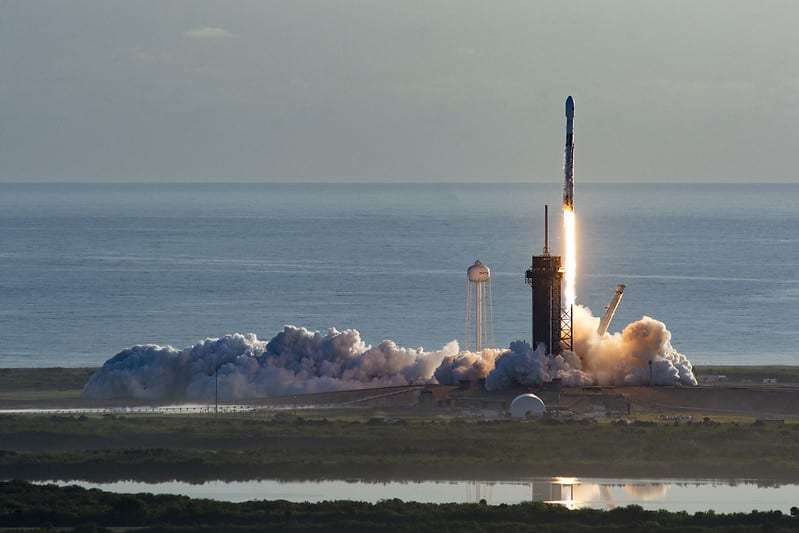
Advertisement
A second major rocket failure happened in early September 2016, when a Falcon 9 exploded during a propellant fill operation for a standard pre-launch static fire test. The payload, the AMOS-6 communications satellite valued at US$200 million, was destroyed. The explosion was caused by the liquid oxygen that is used as propellant turning so cold that it solidified and ignited with carbon composite helium vessels. Though not considered an unsuccessful flight, the rocket explosion sent the company into a four-month launch hiatus while it worked out what went wrong. SpaceX returned to flight in January 2017.
Later that year, in March 2017, SpaceX launched a returned Falcon 9 for the SES-10 satellite. This was the first time a re-launch of a payload-carrying orbital rocket went back to space. The first stage was recovered again, also making it the first landing of a reused orbital class rocket.
2017–2018: Leading global commercial launch provider
In July 2017, the company raised US$350 million, which raised its valuation to US$21 billion. In 2017, SpaceX achieved a 45% global market share for awarded commercial launch contracts. By March 2018, SpaceX had more than 100 launches on its manifest representing about US$12 billion in contract revenue. The contracts included both commercial and government (NASA/DOD) customers. This made SpaceX the leading global commercial launch provider measured by manifested launches.
Advertisement

Advertisement
In 2017, SpaceX formed a subsidiary, The Boring Company, and began work to construct a short test tunnel on and adjacent to the SpaceX headquarters and manufacturing facility, utilizing a small number of SpaceX employees, which was completed in May 2018, and opened to the public in December 2018. During 2018, The Boring Company was spun out into a separate corporate entity with 6% of the equity going to SpaceX, less than 10% to early employees, and the remainder of the equity to Elon Musk.
2019–present: Starship, Starlink, and first crewed launches
In January 2019 SpaceX announced it would lay off 10% of its workforce in order to help finance the Starship and Starlink projects. Construction of initial prototypes and tests for Starship started in early 2019 in Florida and Texas. All Starship construction and testing moved to the new SpaceX South Texas launch site later that year. In May 2019 SpaceX also launched the first large batch of 60 Starlink satellites, beginning the deployment of what would become the world's largest commercial satellite constellation the following year. The company raised a total of US$1.33 billion of capital across three funding rounds in 2019. By May 2019, the valuation of SpaceX had risen to US$33.3 billion and reached US$36 billion by March 2020.
Advertisement

A major milestone was achieved in May 2020, when SpaceX successfully launched two NASA astronauts (Doug Hurley and Bob Behnken) into orbit on a Crew Dragon spacecraft during Crew Dragon Demo-2, making SpaceX the first private company to send astronauts to the International Space Station and marking the first crewed orbital launch from American soil in 9 years. The mission launched from Kennedy Space Center Launch Complex 39A (LC-39A) of the Kennedy Space Center in Florida
On 19 August 2020, after a US$1.9 billion funding round, one of the largest single fundraising pushes by any privately held company, SpaceX's valuation increased to US$46 billion. In February 2021, SpaceX raised an additional US$1.61 billion in an equity round from 99 investors at a per share value of approximately $420, raising the company valuation to approximately US$74 billion. By 2021, SpaceX had raised a total of more than US$6 billion in equity financing. Most of the capital raised since 2019 has been used to support the operational fielding of the Starlink satellite constellation and the development and manufacture of the Starship launch vehicle. By October 2021, the valuation of SpaceX had risen to US$100.3 billion. By 2021, SpaceX had entered into agreements with Google Cloud Platform and Microsoft Azure to provide on-ground computer and networking services for Starlink. A new round of financing in 2022 values SpaceX at US$127 billion.
Advertisement
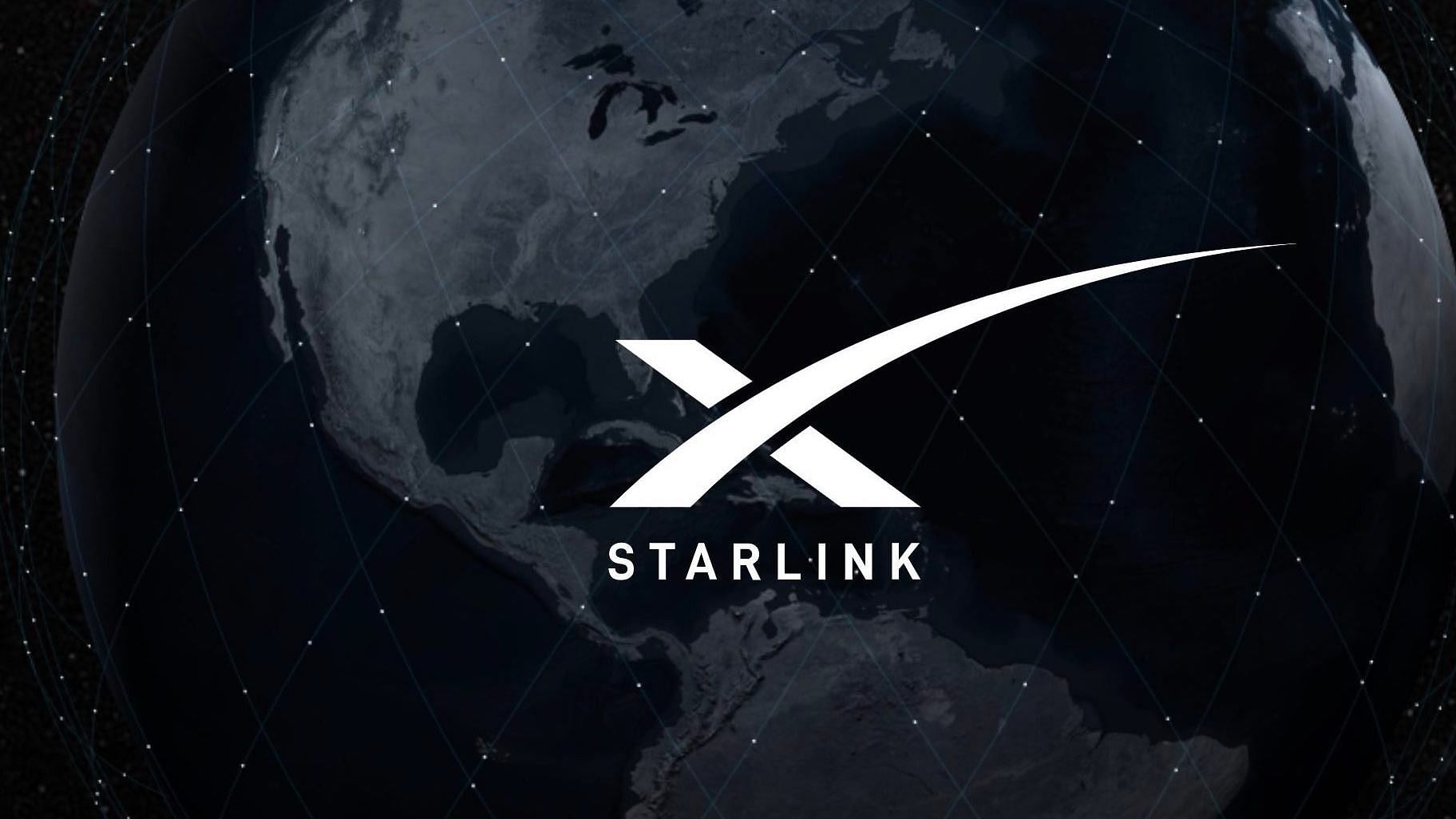
Advertisement
In July 2021, SpaceX unveiled another drone ship named A Shortfall of Gravitas, landing a booster from CRS-23 on it for the first time on 29 August 2021 Within the first 130 days of 2022, SpaceX had 18 rocket launches and two astronaut splashdowns. The majority of 2022 SpaceX launches have focused on Starlink, a consumer internet business that sends batches of internet-beaming satellites and now has over 2,200 satellites in orbit. On 13 December 2021, company CEO Elon Musk announced that the company was starting a carbon dioxide removal program that would convert captured carbon into rocket fuel, after he announced a $100 million donation to the X Prize Foundation the previous February to provide the monetary rewards to winners in a contest to develop the best carbon capture technology.
In August 2022, Reuters reported that the European Space Agency (ESA) began initial discussions with SpaceX that could lead to the company's launchers being used temporarily, given that Russia blocked access to Soyuz rockets amid the Ukraine conflict
Spacex Launch Vehicles
SpaceX has developed three launch vehicles. The small-lift Falcon 1 was the first launch vehicle developed and was retired in 2009. The medium-lift Falcon 9 and the heavy-lift Falcon Heavy are both operational. The Falcon 1 was a small rocket capable of placing several hundred kilograms into low Earth orbit. It launched five times between 2006 and 2009, of which 2 were successful. The Falcon 1 was the first privately funded, liquid-fueled rocket to reach orbit.
Advertisement

Advertisement
Falcon 9 is a medium-lift launch vehicle capable of delivering up to 22,800 kilograms (50,265 lb) to orbit, competing with the Delta IV and the Atlas V rockets, as well as other launch providers around the world. It has nine Merlin engines in its first stage. The Falcon 9 v1.0 rocket successfully reached orbit on its first attempt on 4 June 2010. Its third flight, COTS Demo Flight 2, launched on 22 May 2012, and launched the first commercial spacecraft to reach and dock with the International Space Station (ISS). The vehicle was upgraded to Falcon 9 v1.1 in 2013, Falcon 9 Full Thrust in 2015, and finally to Falcon 9 Block 5 in 2018. The first stage of Falcon 9 is designed to retropropulsively land, be recovered, and reflown.
The Falcon Heavy is a heavy-lift launch vehicle capable of delivering up to 63,800 kg (140,700 lb) to Low Earth orbit (LEO) or 26,700 kg (58,900 lb) to geosynchronous transfer orbit (GTO). It uses three slightly modified Falcon 9 first stage cores with a total of 27 Merlin 1D engines. The Falcon Heavy successfully flew its inaugural mission on 6 February 2018, launching Musk's personal Tesla Roadster into heliocentric orbit
Both the Falcon 9 and Falcon Heavy are certified to conduct launches for the National Security Space Launch (NSSL).As of 5 October 2022, the Falcon 9 and Falcon Heavy have been launched 182 times, resulting in 180 full mission successes, one partial success, and one in-flight failure. In addition, a Falcon 9 experienced a pre-flight failure prior to a static fire test in 2016.
Rocket engines
Since the founding of SpaceX in 2002, the company has developed several rocket engines – Merlin, Kestrel, and Raptor – for use in launch vehicles, Draco for the reaction control system of the Dragon series of spacecraft, and SuperDraco for abort capability in Crew Dragon.
Advertisement

Advertisement
Merlin is a family of rocket engines that uses liquid oxygen (LOX) and RP-1 propellants. Merlin was first used to power the Falcon 1's first stage and is now used on both stages of the Falcon 9 and Falcon Heavy vehicles. Kestrel uses the same propellants and was used as the Falcon 1 rocket's second stage main engine.
Draco and SuperDraco are hypergolic liquid-propellant rocket engines. Draco engines are used on the reaction control system of the Dragon and Dragon 2 spacecraft. The SuperDraco engine is more powerful, and eight SuperDraco engines provide launch escape capability for crewed Dragon 2 spacecraft during an abort scenario.
Raptor is a new family of liquid oxygen and liquid methane-fueled full-flow staged combustion cycle engines to power the first and second stages of the in-development Starship launch system. Development versions were test-fired in late 2016, and the engine flew for the first time in 2019, powering the Starhopper vehicle to an altitude of 20 m (66 ft).
Dragon spacecraft
SpaceX has developed the Dragon spacecraft to transport cargo and crew to the International Space Station. The first version of Dragon, used only for cargo, was first launched in 2010. The currently operational second generation Dragon spacecraft, known as Dragon 2, conducted its first flight, without crew, to the ISS in early 2019, followed by a crewed flight of Dragon 2 in 2020. The cargo variant of Dragon 2 flew for the first time in December 2020, for a resupply to the Space Station as part of the CRS contract with NASA.
Advertisement
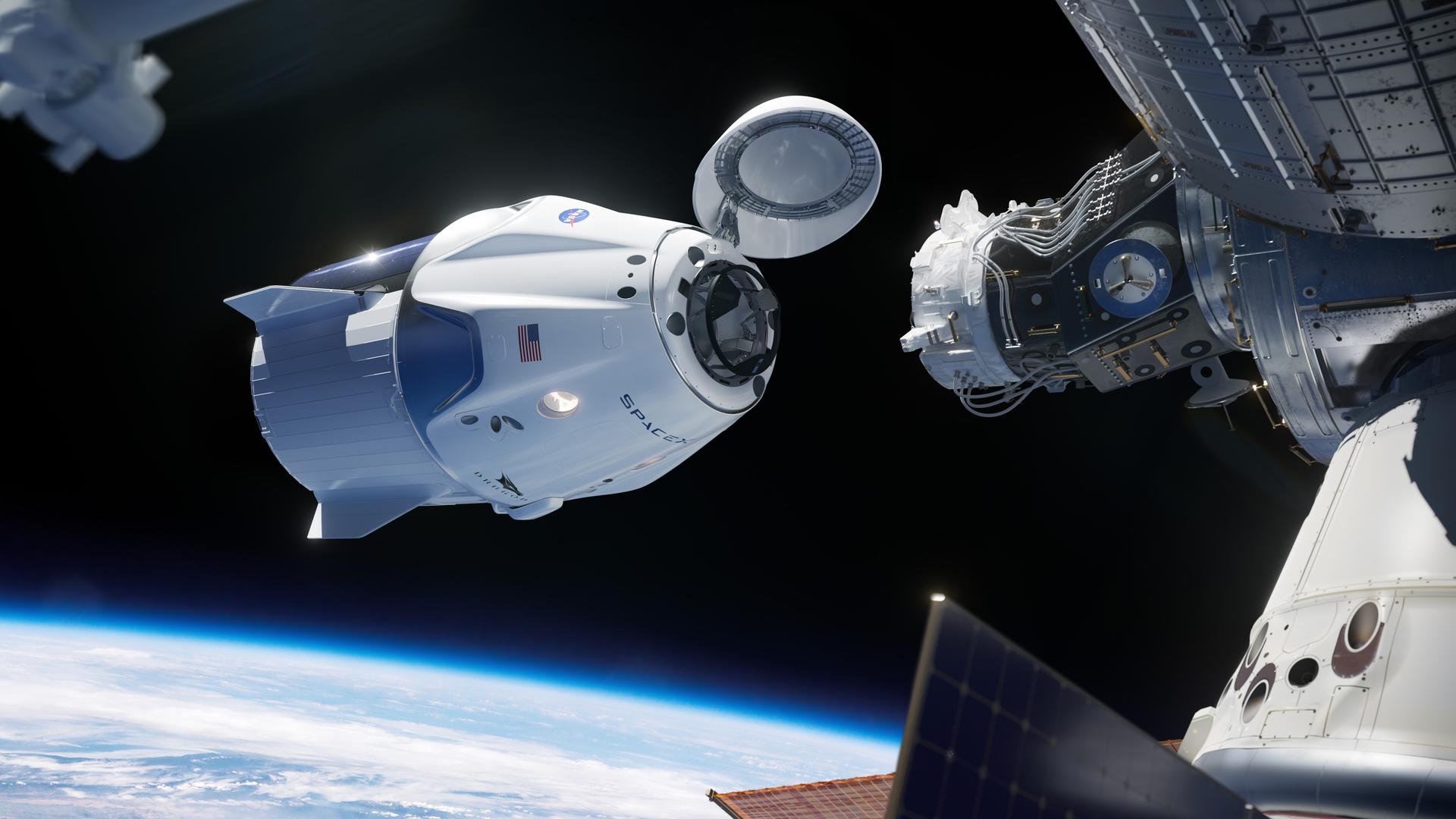
Advertisement
In March 2020 SpaceX revealed the Dragon XL, designed as a resupply spacecraft for NASA's planned Lunar Gateway space station under a Gateway Logistics Services (GLS) contract. Dragon XL is planned to launch on the Falcon Heavy, and is able to transport over 5,000 kg (11,000 lb) to the Gateway. Dragon XL will be docked at the Gateway for six to twelve months at a time.
Autonomous spaceport drone ships
SpaceX routinely returns the first stage of Falcon 9 and Falcon Heavy rockets after orbital launches. The rocket flights and land to a predetermined landing site using only its own propulsion systems. When propellent margins do not permit a return to launch site (RTLS), rockets return to floating landing platform in the ocean, called autonomous spaceport drone ships (ASDS).
Advertisement

Advertisement
SpaceX also plans to introduce floating launch platforms. These are modified oil rigs to use in the 2020s to provide a sea launch option for their second-generation launch vehicle: the heavy-lift Starship system, consisting of the Super Heavy booster and Starship second stage. SpaceX has purchased two deepwater oil rigs and are refitting them to support Starship launches.
Starship
SpaceX is developing a fully reusable super-heavy lift launch system known as Starship. It comprises a reusable first stage, called Super Heavy, and the reusable Starship second stage and space vehicle. The system is intended to supersede the company's existing launch vehicle hardware by the early 2020s.
SpaceX initially envisioned a 12-meter-diameter ITS concept in 2016 solely aimed at Mars transit and other interplanetary uses. In 2017 it articulated a smaller 9-meter-diameter vehicle to replace all of its launch service provider capabilities—Earth-orbit; lunar-orbit; interplanetary missions; and potentially, even intercontinental passenger transport on Earth—but do so on a fully reusable set of vehicles with a markedly lower-cost structure.
Advertisement
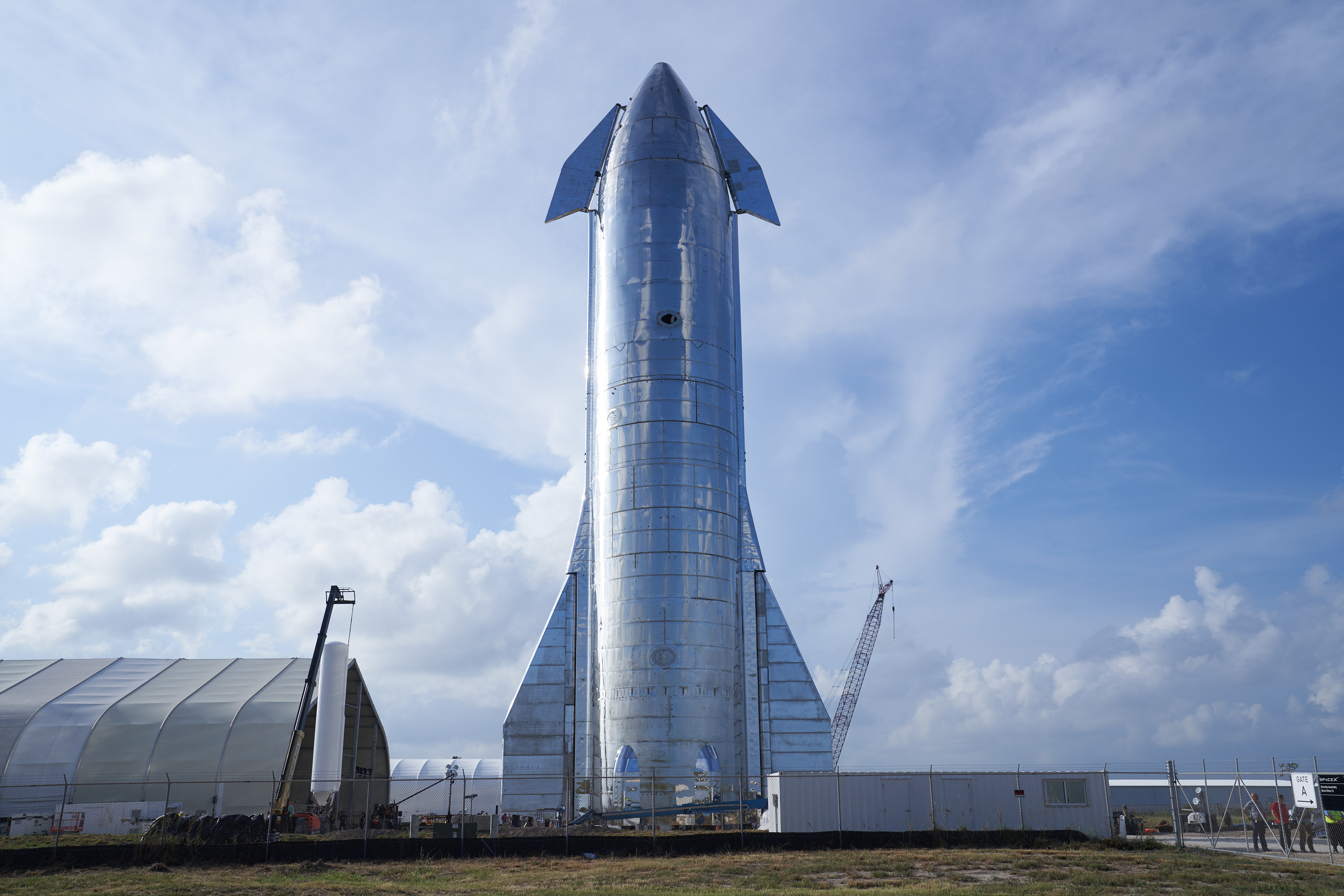
Advertisement
In 2018, the Starship system was redesigned to use stainless steel instead of carbon fiber construction, to improve performance while drastically decreasing cost. Private passenger Yusaku Maezawa has contracted to fly around the Moon in a Starship vehicle in 2023. The company's long-term vision is the development of technology and resources suitable for human colonization of Mars.
SpaceX started manufacturing the first prototypes of Starship in 2019 at the company's facility in Boca Chica, Texas, later renamed Starbase. It is developing Starship using iterative design principles, aiming to build and test several prototypes at a fast pace. The first successful suborbital flight and landing of a full Starship prototype was achieved in May 2021.
Starlink
Starlink is an internet satellite constellation under development by SpaceX. It will use 4,425 cross-linked communications satellites in 1,100 km orbits. Owned and operated by SpaceX, its goal is to increase profitability and cash flow to allow SpaceX to build its Mars colony. Development began in 2015, and initial prototype test-flight satellites were launched on the SpaceX Paz satellite mission in 2017. In May 2019 SpaceX launched the first batch of 60 satellites aboard a Falcon 9. By May 2021, it had launched 1737 Starlink satellites. Initial test operation of the constellation began in late 2020.
Advertisement
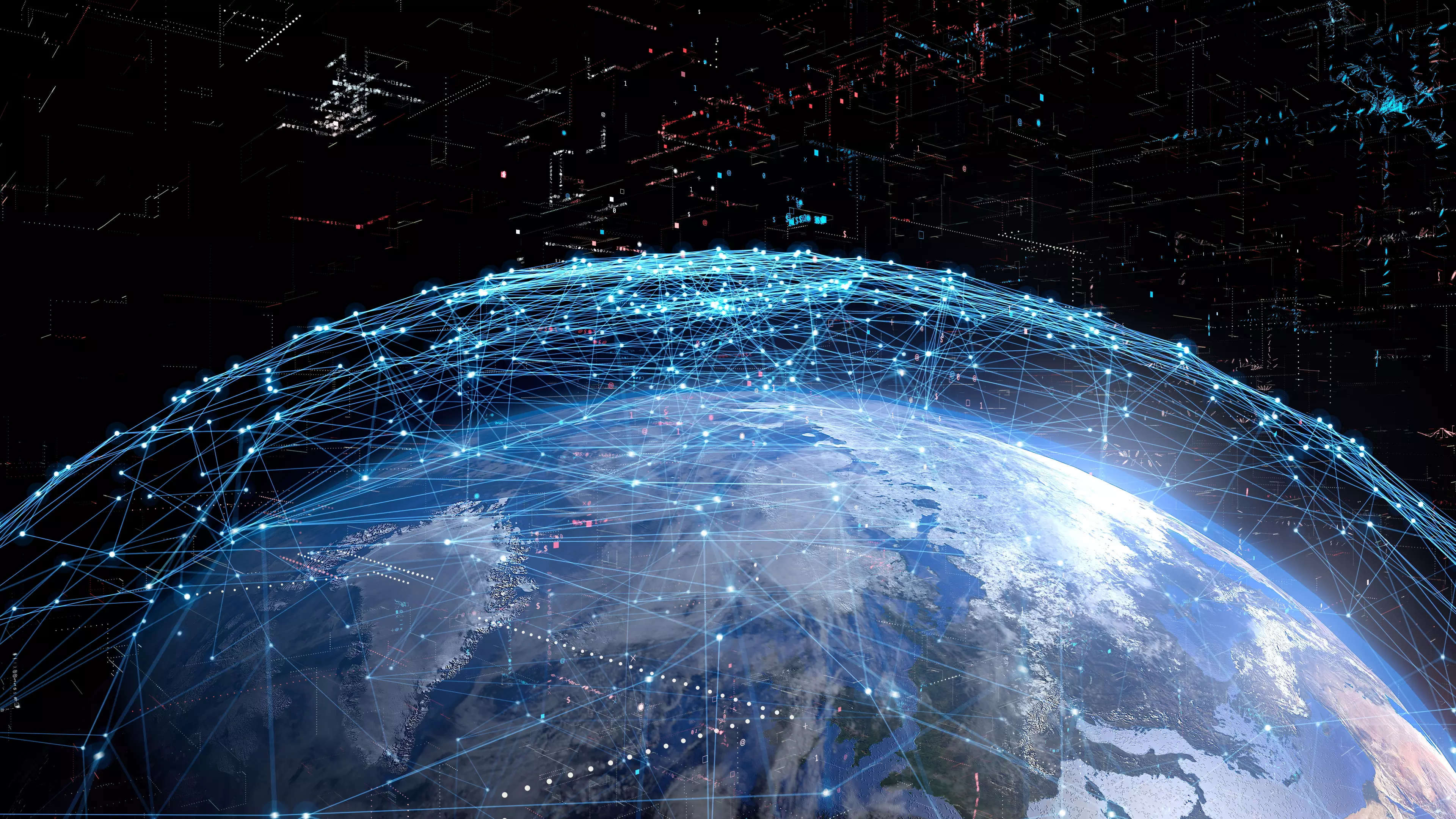
Advertisement
In March 2017 SpaceX filed plans with the Federal Communications Commission to field a constellation of 7,518 additional V-band satellites in non-geosynchronous orbits to provide communications services. In February 2019 it formed a sibling company, SpaceX Services, Inc., to license the manufacture and deployment of up to 1,000,000 fixed satellite Earth stations that will communicate with its Starlink system. On 15 May 2021, SpaceX and Google collaborated to provide data and cloud services for Starlink Enterprise customers.
The planned large number of Starlink satellites has been criticized by astronomers due to concerns over light pollution, with the brightness of Starlink satellites in both optical and radio wavelengths interfering with scientific observations. In response, SpaceX has implemented several upgrades to Starlink satellites aimed at reducing their brightness. The large number of satellites employed by Starlink also creates long-term dangers of space debris collisions. However, the satellites are equipped with krypton-fueled Hall thrusters which allow them to de-orbit at the end of their life. They are also designed to autonomously avoid collisions based on uplinked tracking data.
Other projects.
In June 2015 SpaceX announced that they would sponsor a Hyperloop competition, and would build a 1.6 km (0.99 mi) long subscale test track near SpaceX's headquarters for the competitive events. The company has held the annual competition since 2017.
In collaboration with doctors and academic researchers, SpaceX invited all employees to participate in the creation of a COVID-19 antibody-testing program in 2020. As such 4300 employees volunteered to provide blood-samples resulting in a peer-reviewed scientific paper crediting eight SpaceX employees as coauthors and suggesting that a certain level of COVID-19 antibodies may provide lasting protection against the virus.
In July 2018, Musk arranged for his employees to build a mini-submarine to assist the rescue of children stuck in a flooded cavern in Thailand. Richard Stanton, leader of the international rescue diving team, urged Musk to facilitate the construction of the vehicle as a back-up, in case flooding worsened. Engineers at SpaceX and The Boring Company built the mini-submarine from a Falcon 9 liquid oxygen transfer tube in eight hours and personally delivered it to Thailand. By this time, however, eight of the 12 children had already been rescued using full face masks and oxygen under anesthesia; consequently Thai authorities declined to use the submarine.